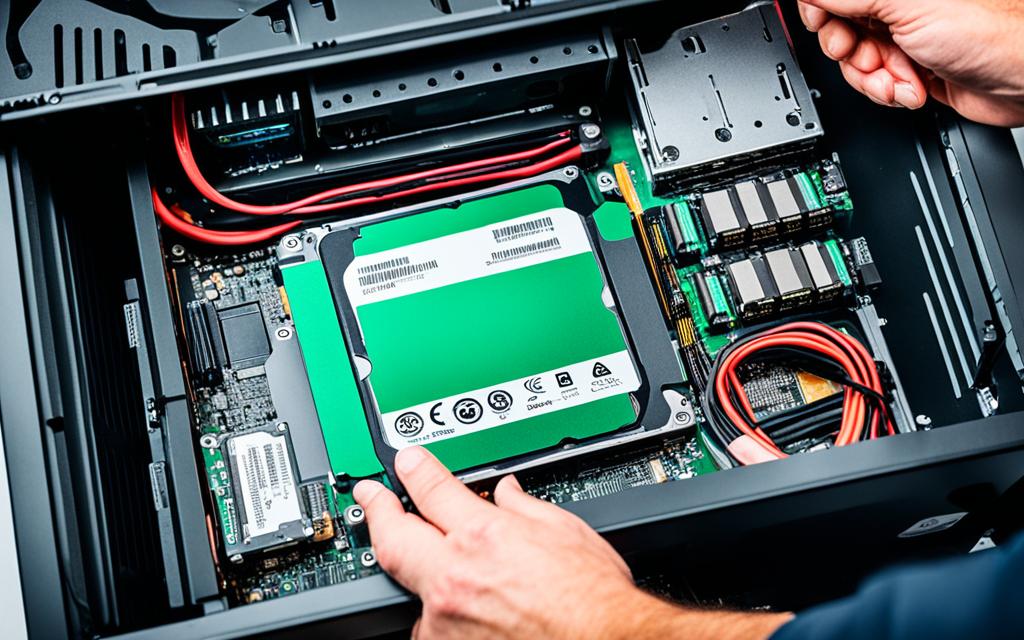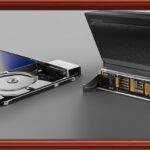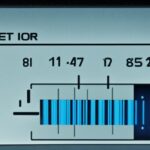Table of Contents
Installing a new internal hard disk drive (HDD) can give your computer a big boost. It’s a simple and affordable way to increase space for all your data and programs. Most consumer HDDs spin at 7,200 RPM, offering reliable performance without costing too much1. While SSDs are faster, many excellent HDD options are available for those wanting to add HDD to your PC. Companies like Seagate, Toshiba, and WD make HDDs, such as the Seagate BarraCuda. These range from 2TB to 8TB and are priced to fit different budgets, making them ideal for upgrading your computer12.
We will walk you through the key steps to install your HDD properly. Our guide covers everything from getting ready to completing the setup. This ensures your new HDD works smoothly, increasing your computer’s storage space.
Key Takeaways
- Internal HDDs typically run at 7,200 RPM for optimal speed.
- Popular internal HDD models include Seagate BarraCuda and WD Black.
- SATA drives are the standard for modern computers, available in 3.5-inch and 2.5-inch sizes.
- Using static wrist bands while working on your PC is advisable to prevent static damage.
- Back up your data before beginning the installation to protect against data loss.
Understanding Hard Disk Drives
Hard Disk Drives (HDDs) are widely used for storing data in computers. They are available in various types to meet different needs. The choice between HDDs and Solid-State Drives (SSDs) sparks interesting conversations about storage tech.
Types of HDDs
HDDs mainly come in two sizes: 3.5-inch and 2.5-inch. 3.5-inch HDDs are often found in desktops, while smaller 2.5-inch ones fit in laptops. Even though SSDs are becoming more popular, many computers still use 3.5-inch drive bays, adapting to new design needs3.
Advantages of HDDs Over SSDs
HDDs are great because they keep data safe even when turned off. They’re also more affordable than SSDs, offering more space for less money. Though not as fast as SSDs, HDDs are dependable for various storage needs, especially in older setups4.
Setting up an HDD is easy, needing just a few tools. Anyone can do it with a screwdriver, SATA cable, and some screws. This makes HDDs user-friendly5.
| Feature | HDDs | SSDs |
|---|---|---|
| Cost per GB | Lower | Higher |
| Speed | Slower | Faster |
| Durability | Less durable | More durable |
| Power Consumption | More power consumption | Less power consumption |
HDDs and SSDs differ in speed, cost, and durability. These differences affect what users pick and how they set up their systems5.
Choosing the Right HDD for Your Computer
Choosing the right HDD for your PC really affects its function and speed. There are mainly two sizes to think about: the 3.5-inch and the 2.5-inch. Each type works best for certain computers, helping you decide based on what you need.
Form Factors: 3.5-inch vs 2.5-inch
Big desktop computers usually go for the 3.5-inch HDDs. They have a lot of space, up to 20TB. This is perfect for gamers or media experts who need lots of room. On the other hand, laptops use the 2.5-inch HDDs. They are smaller and made to be moved around, but still offer up to 10TB of space. Knowing these sizes helps make sure the HDD fits your device right.
Recommended HDD Brands and Models
When picking a HDD brand, Seagate, Toshiba, and Western Digital are top choices because they are reliable and perform well. For example, the Seagate BarraCuda comes in sizes from 2TB to 8TB and works really well. Toshiba X300 is also great for balancing speed and storage. WD Black is best for quick data transfers, making these brands leading options.
Knowing all this, you can choose a HDD that fits your tech needs perfectly. The right pick not only boosts your computer’s speed but also makes sure your data is safe for a long time. Each decision greatly affects your computer use, so think carefully about your options6.
Preparation for Installation
Getting ready for an HDD install is key to make sure everything goes smoothly. Paying close attention and properly preparing helps avoid delays and mistakes. Here are the essentials you’ll need and what to watch out for.
Tools You Will Need
Before you begin installing a hard disk drive, make sure you have these tools:
- Philips screwdriver
- Anti-static wristband (optional but recommended)
- Clean, flat surface for your workspace
- External drive or cloud storage for data backup
Having these tools ready helps make your installation smoother and ensures you’re prepared.
Backing Up Your Data
Backing up your data is crucial before you start the installation. Use external drives or trusted cloud services like Google Drive or OneDrive. This step keeps your files safe during the installation process.
Ensuring all important files are securely backed up gives you peace of mind.
Being prepared with the right tools and a data backup plan makes the HDD installation easier. With everything set, moving to the next steps is less worrying7.
How to Install an HDD
Installing an HDD is a step-by-step journey. First, make sure your computer is off and unplugged. Then, opening the side panel makes it easier to put in the new hard drive.
When replacing an old HDD, take care when disconnecting it. Next, put the new HDD in the right drive bay. Often, hard drives come with special software to help set them up8.
Remember, some old power supplies might not have SATA connectors. You might get a SATA power adapter with your drive. It’s wise to have two extra SATA power adapters ready8. Securing the drive can vary, using clips or clamps, depending on your computer.
Once the HDD is in place, connect the SATA data cable to the hard drive and motherboard. If the computer doesn’t see the new drive, check the BIOS settings9. By following these instructions, you’ll have a smooth HDD setup.
Mounting the HDD in Your PC Case
Mounting the HDD is key for setting up your computer. It’s important to know where the drive bay is and how to secure the hard drive properly. Doing so ensures your system works well and stays stable. Most PC cases have a specific spot for the hard drive, usually at the bottom front. This helps keep the hard drive cool by allowing air to flow around it.
Locating the Drive Bay
Finding the right spot for a second hard drive is crucial, especially in gaming PCs. These computers are made to be easy to upgrade10. To start, open your case and look for the hard drive slots. Make sure nothing already there will get in the way of the new drive.
Securing the Drive With Screws or Tool-less Trays
After placing the hard drive in the bay, you need to secure it. You can use screws or tool-less trays found in newer cases11. Securing it well prevents any movement, reducing noise and avoiding damage. Also, leave enough space between drives to keep them cool. This helps them work better and last longer11.
Make sure all connections are secure after installing. This is crucial to avoid problems when you start your computer10. Also, ground yourself to avoid damaging any parts with static electricity10. For detailed instructions on installing different hard drives, check out the complete guide11.
Connecting the HDD to Your System
After securing the HDD, connect it to your system next. This lets data move between the HDD and the motherboard. It makes your experience efficient.
Using SATA Cables for Data Transfer
The main way to link HDD units is with SATA cables. These cables are crucial for smooth data transfer. First, plug one end of the SATA cable into the HDD. Then connect the other end to a SATA port on the motherboard. When making this SATA connection, check the cable is tight for the best performance. You can find steps for easy installation in the detailed guide on connecting new hard drives12.
Powering the HDD with Your PSU
The HDD needs power to work properly after you connect it for data transfer. This power comes from your computer’s power supply unit (PSU). Link the SATA power connector from the PSU to the HDD’s port. Make sure it’s securely connected. Doing this right helps prevent problems and ensures the HDD works well13. By following these instructions, you can also save money by installing the HDD yourself.
Initial Setup and Formatting of the HDD
After you install your new hard drive, the first task is setting it up. When you start your computer, you’ll go into the BIOS/UEFI. Here, your new drive should appear if everything’s connected right. It’s important to check if the HDD shows up, as this means everything’s working. If you can’t see the HDD in BIOS, it might mean a connection problem.
Accessing the BIOS/UEFI
To get into the BIOS or UEFI, you need to restart your computer. Press the key needed (like F2, Del, or Esc) while the computer boots. This brings up the settings where you can see if the hard drive is recognized. If it is, you’re ready to set up the hard drive for storing data. Remember to save any changes in the BIOS before you leave.
Partitioning and Formatting the Drive in Windows
With the BIOS settings done, the next step is to format the drive. Windows will ask you to format the new hard drive, getting it ready for use. You’ll use the Disk Management utility for this. This tool helps you create partitions, give drive letters, and quickly format the space. Using the Disk Management tool makes sure the new drive shows up in File Explorer once formatted. Now, your new HDD should be ready, formatted, and visible.
| Step | Action |
|---|---|
| 1 | Access BIOS/UEFI to verify HDD detection |
| 2 | Restart system and enter the designated key |
| 3 | Navigate to Disk Management |
| 4 | Create partitions and assign drive letters |
| 5 | Perform a quick format |
Before installing, using a good partitioning tool can make formatting easier. EaseUS Partition Master comes highly recommended for its simple interface and support for Windows 10 and 1114. Properly formatting the hard drive prepares it for effective data management15.
Conclusion
Installing a new HDD boosts your computer’s skills and empowers you as a user. This guide’s steps, from choosing the right hard drive to final steps, make it easy for everyone. It takes 10-20 minutes to install, and technical know-how greatly enhances storage and performance16.
You need SATA cables, a screwdriver, and screws for a simple setup. With these tools, you’ll enjoy better file management and gaming. These benefits highlight the perks of upgrading your storage1617.
This article equips you to improve your system’s potential confidently. It offers you a chance to not just add more storage. But to also organise your digital life better, ensuring your PC keeps up with your needs.
FAQ
What is the difference between HDD and SSD?
HDDs and SSDs use different technologies. HDDs have moving parts and offer lots of storage cheaply. SSDs, on the other hand, are faster and more reliable but cost more because they use flash memory.
How do I know which size HDD to choose for my computer?
Choosing the right HDD size means looking at the form factor. Desktops usually need 3.5-inch drives. Compacts and laptops often use 2.5-inch ones. Make sure it fits your system before you buy it.
Can I install an HDD without prior experience?
Yes, anyone can install an HDD. You just need to follow a good guide carefully. Make sure you have the necessary tools and take the right safety steps.
What tools do I need for installing an HDD?
You only really need a Philips screwdriver to put in an HDD. Anti-static wristbands are good to have, too, to avoid damage from static electricity. And don’t forget to keep your workspace tidy.
Is it necessary to backup my data before installing a new HDD?
Definitely. Always back up your data before starting. You can use external drives or online cloud storage like Google Drive or OneDrive for this. It’s crucial to avoid losing any files.
How do I format the new HDD after installation?
Once your HDD is in and your computer is on, check the BIOS/UEFI to see if it’s detected. Then, go to Disk Management in Windows to set up and format your new drive for storing files.
Which HDD brands are highly recommended?
Recommended brands include Seagate BarraCuda for its versatile range, Toshiba X300 for reliability, and WD Black for top speed and performance.
How can I ensure my HDD is securely mounted?
Make sure the HDD is tightly fixed in the bay with screws or a tool-less tray. This is important to stop it from moving, causing noise or damage.
What is the significance of SATA cables during installation?
SATA cables connect the HDD to the motherboard for data transfer. One end plugs into the HDD, the other to the motherboard. This ensures your drive works properly.
What are the advantages of using HDDs for storage?
HDDs are great for their low cost per gigabyte, big storage options, and fitting those with lots of data. They’re a budget-friendly choice for maximizing storage space.
Source Links
- https://www.pcworld.com/article/535852/how-to-install-a-new-hard-drive-in-your-desktop-pc.html – How to install a hard drive in your computer
- https://www.wikihow.com/Install-a-Hard-Drive – 3 Easy Ways to Install a Hard Drive: Guide (With Pictures)
- https://www.computerhope.com/issues/ch000413.htm – How to Install a Hard Drive or SSD
- https://www.crucial.com/articles/pc-builders/what-is-a-hard-drive – What is a Hard Disk Drive? | HDDs Explained
- https://beebom.com/how-install-hard-drive-desktop-pc/ – How to Install Hard Drive (HDD) in Your Desktop PC
- https://www.seagate.com/blog/how-to-choose-between-hdd-storage-for-your-laptop-master-dm/ – How to Choose Between SSD, SSHD, and HDD Storage for Better Laptop Performance | Seagate US
- https://docs.redhat.com/en/documentation/red_hat_enterprise_linux/6/html/installation_guide/s1-steps-hd-installs-ppc – 12.2. Preparing for a Hard Drive Installation
- https://www.ifixit.com/Wiki/Installing_a_Hard_Drive – Installing a Hard Drive
- https://www.dummies.com/article/technology/computers/operating-systems/windows/windows-10/how-to-install-a-second-internal-hard-drive-on-your-windows-10-device-255316/ – How to Install a Second Internal Hard Drive on Your Windows 10 Device
- https://www.fiercepc.co.uk/blog/guides/extra-hdd – How to add an extra hard drive to your PC
- https://www.helpwithpcs.com/upgrading/install-hard-drive.htm – How to install a hard drive
- https://www.easeus.com/partition-master/install-a-new-hard-drive-or-ssd.html – Beginner’s Guide – Install A New Hard Drive/SSD in Windows 10/8/7
- https://www.hp.com/us-en/shop/tech-takes/how-to-replace-a-hard-drive-and-reinstall – How to Replace a Hard Drive and Reinstall an Operating System
- https://www.easeus.com/partition-manager-software/format-hard-drive-while-installing-windows.html – Can I Format Hard Drive While Installing Windows 11/10/7? Yes and Here Is How-To
- https://www.reddit.com/r/buildapc/comments/908f0n/guide_for_adding_a_storage_drive_to_your_pc_for/ – Reddit – Dive into anything
- https://www.easeus.com/partition-manager-software/install-a-new-hard-drive-on-windows-11.html – Tutorial: Install a New Hard Drive on Windows 11 Safely
- https://www.diskpart.com/windows-10/how-to-install-a-second-hard-drive-windows-10-1503.html – How to Install a Second Hard Drive Windows 10 | Detailed Tutorial








